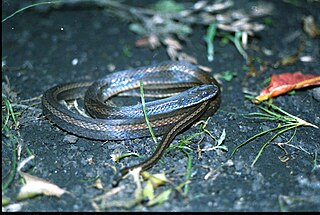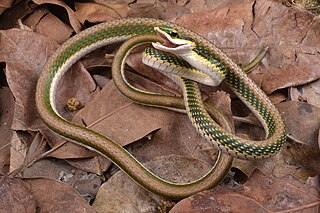
Spiny lizards is a common name for the genus Sceloporus in the family Phrynosomatidae. The genus is endemic to North America, with various species ranging from New York, to Washington, and one occurring as far south as northern Panama. The greatest diversity is found in Mexico. This genus includes some of the most commonly seen lizards in the United States. Other common names for lizards in this genus include fence lizards, scaly lizards, bunchgrass lizards, and swifts.

Bothriechis schlegelii, known commonly as the eyelash viper, is a species of venomous pit viper in the family Viperidae. The species is native to Central and South America. Small and arboreal, this species is characterized by a wide array of color variations, as well as the superciliary scales above the eyes. It is the most common of the green palm-pitvipers, and is often present in zoological exhibits. The specific name schlegelii honors Hermann Schlegel, who was a German ornithologist and herpetologist. For other common names see below. No subspecies are currently recognized as being valid.

Bothriechis is a genus of venomous pit vipers, commonly called palm vipers or palm-pitvipers found predominantly in Mexico and Central America, although the most common species, B. schlegelii, ranges as far south as Colombia and Peru. All members are relatively slender and arboreal. The name Bothriechis is derived from the Greek words bothros and echis that mean "pit" and "viper" respectively. Ten species and no subspecies are currently generally recognized.

Tantilla is a large genus of harmless New World snakes in the family Colubridae. The genus includes 66 species, which are commonly known as centipede snakes, blackhead snakes, and flathead snakes.

Coniophanes is a genus of colubrid snakes, commonly referred to as black-striped snakes, but they also have many other common names. The genus consists of 17 species, and despite the common name, not all of them display striping.

Porthidium dunni is a species of venomous pitviper in the family Viperidae. The species is endemic to Mexico. There are no recognized subspecies.
Emmett Reid Dunn was an American herpetologist noted for his work in Panama and for studies of salamanders in the Eastern United States.

Leptophis mexicanus, commonly known as the Mexican parrot snake, is a species of medium-sized slender snake in the family Colubridae. The species is endemic to the Americas.

Ninia sebae, commonly known as the redback coffee snake or the red coffee snake, is a species of small terrestrial snake in the family Colubridae. The species is endemic to Mexico and Central America south to Costa Rica. Although it resembles some venomous coral snakes in color and size, it is not venomous and seldom bites humans.

Geophis is a genus of snakes in the subfamily Dipsadinae of the family Colubridae of the superfamily Colubroidea. Species in the genus Geophis are commonly referred to as Latin American earth snakes. The genus consists of 53 distinct species.
The isthmian alligator lizard is a species of lizard of the Anguidae family. G. rhombifer is found in both Costa Rica and Panama. Unlike many lizards near its habitat, individuals have lateral folds. They give birth to live young. Gerrhonotus rhombifer had not been seen for fifty years, prior to being rediscovered in 2000 near Golfito, and is one of the rarest species of lizard in Costa Rica.

Scaphiophis is a genus of African snakes in the family Colubridae. Common names include hook-nosed snakes and shovel-nosed snakes.
Trimetopon is a genus of snakes in the family Colubridae. The genus is native to Costa Rica and Panama. Species in the genus Trimetopon are known commonly as tropical ground snakes.

Urotheca is a genus of snakes of the family Colubridae. The genus is endemic to the New World.

Conophis is a genus of snakes in the subfamily Dipsadinae of the family Colubridae. The genus is endemic to Mexico and Central America.
Wahlberg's Kalahari gecko, also known commonly as the Kalahari ground gecko, is a species of lizard in the family Gekkonidae. The species is native to southern Africa.
The Colombian longtail snake, also known commonly as the sock-headed snake and the white-headed snake, is a species of snake in the family Colubridae. The species, which is monotypic in the genus Enuliophis, is native to Central America and northern South America.

Geophis dunni, Dunn's earth snake, is a species of enigmatic snake in the family Colubridae. The species is presumably endemic to Nicaragua and is only known from a single specimen discovered in 1932. This specimen, the holotype, was discovered by Karl Patterson Schmidt in the stomach of a Central American coral snake, and no additional specimen has been seen since. The holotype has a snout-to-vent length (SVL) of 310 mm (12 in), a tail length of 57 mm (2.2 in), and a total length of 367 mm (14.4 in). It is part of the Geophis sieboldi species group according to Floyd Leslie Downs. This species was named by Schmidt after fellow herpetologist Emmett Reid Dunn "in allusion to his important contributions to our knowledge of this group of snakes".
Hydromorphus concolor, also known as the Costa Rica water snake, is a snake of the colubrid family. It is found in Guatemala, Honduras, Nicaragua, Costa Rica, Panama, and Colombia.
Hydromorphus dunni, also known as Dunn's water snake, is a snake of the colubrid family. It is found in Panama.












